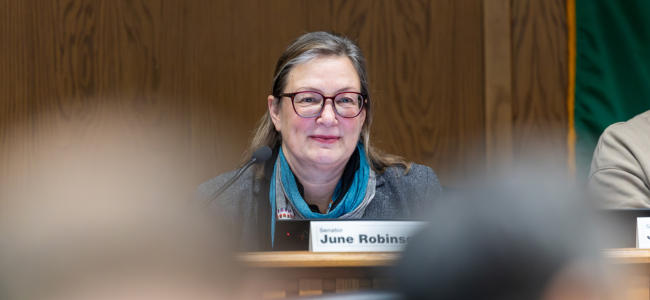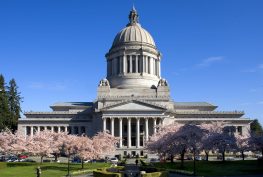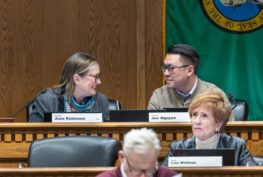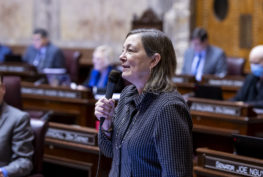OLYMPIA – Budget leaders in both chambers unveiled an agreed-to budget that puts Washington’s families and students first. The supplemental budget, which builds on last year’s biennial budget, also makes the state’s biggest commitment ever in combating substance use disorder in our communities – a priority for Democrats in both chambers.
Supplemental budgets traditionally roll out to lower fanfare and often address minor tweaks and adjustments where necessary. But Democrats identified needs in communities across the state and directed funding to ensure no one is left behind as the state continues to support families and individuals recovering from the COVID-19 pandemic.
“This spending plan underscores our dedication to responsible governance and meeting the pressing needs of communities statewide. It reflects our shared values and priorities by strategically investing in essential areas, such as our public schools and behavioral health system, while also supporting affordable housing, homelessness prevention, and clean energy,” said Sen. June Robinson (D-Everett), chair of the Senate Ways & Means Committee. “We must ensure our neighbors have the resources needed to thrive here – that’s exactly what this budget does.”
“Washington state has one of the best economies in the country, but not all families are feeling that economic security. This budget reflects the needs of those who are struggling the most, including our overburdened and underrepresented communities, and continues to fund necessary supports in a sustainable way. Our smart, targeted investments combined with our responsible approach to budgeting and diverse tax base is one of the reasons why we have excellent credit ratings and are seen as a leader across the nation,” said Rep. Timm Ormsby (D-Spokane), House Appropriations Chair.
Substance use disorder and the rise of fentanyl in our communities received bipartisan focus this year, with a package of bills introduced and passed by both chambers. In addition, the supplemental budget invests heavily in access to treatment, education, awareness, outreach, and prevention with $215 million in new funding. That is on top of the additional $245 million in behavioral health capacity, rate increases, and outpatient and personal care programs.
Public schools receive $335 million in additional funding to help address the rise in insurance costs, pay for paraeducator staffing, and increasing the special education funding cap to 16%. Childcare and early learning receive additional funding to the tune of $115 million to increase provider rates and reimbursements.
Ensuring families stay in their homes continues to be a priority in this budget, with $230 million in investments to support local homelessness services, supporting tenants’ rights and homeownership programs, and a new low- and moderate-income clean energy assistance program that will provide a credit to qualifying utility customers in September. Food assistance for seniors, summer EBT for kids, and support for food banks also receive $64 million in additional funding this year.
Local governments will no longer have to cover a quarter of the cost of training new cadets at law enforcement academies as the budget allocates $4 million for the state to cover 100%of that cost. This approach lowers the burden to local jurisdictions and, in combination to the state’s expansion of training locations, allows more cadets to be trained and enter the law enforcement field.
Climate, clean energy, and natural resource funding is increased by $335 million, with a large portion of that funding coming from the Climate Commitment Act (CCA). That funding includes payments to agricultural fuel users exempt from the CCA and existing clean energy and climate programs to help communities prepare for droughts, flooding, and other potential risks stemming from the climate crisis.
Higher education institutions and workforce development receive an additional $135 million to expand programs and support students, while long-term care and developmental disabilities funding increases by $77 million. That helps support a 2.5% rate increase for assisted-living and supported-living providers and new beds for youth with complex developmental disabilities and behavioral health needs.
Newly arriving immigrants, asylees, and refugees are supported with $36 million in basic needs, employment and training, health care, and housing supports. Small business and economic development programs also see a boost with $13 million, and broadband access, digital equity and literacy are funded with $8 million. These line items reflect just some of the targeted equity investments that are part of the Democratic approach to ensuring all communities are given access to achieving economic stability.
The supplemental operating budget adds about $3 billion in total funding to address maintenance level increases, including Medicaid, food assistance, and K-12 enrollment caseloads, as well as the mandatory Trueblood case investments. Approximately $4.1 billion in total reserves remain in the two-year budget, or about 11.8%.
Both chambers will vote on the proposal Thursday, the last day of the 60-day 2024 legislative session.
For more information:
Budget details are available at fiscal.wa.gov.
The signing of the conference committee report is available on TVW here. (11:30 a.m. Wednesday, March 6)
Senate and House floor votes will be streamed on TVW.



